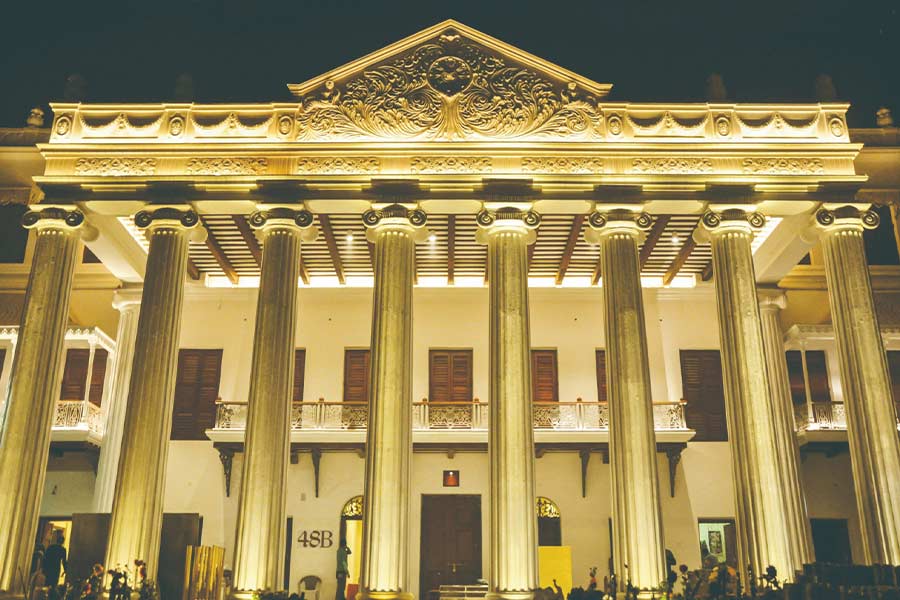North Kolkata has many hidden gems. There are still several grand mansions — many of which have lost their past glory — but their presence reveals their past grandeur and rather interesting history. For example, there still remains a house in north Kolkata where Satyajit Ray and Sunil Gangopadhyay were regular visitors.
If you are a foodie and have had the opportunity to visit Shyampukur Street in Hatibagan, there is a chance you have visited the restaurant ‘Only 4 Chinese Gazab’, which is located inside the ground floor of a grand mansion renowned as the Shyampukur Mitra Bati. The house is divided at present among its many of its descendants
As one enters the premises of present-day Shyampukur Mitra Bati adjacent to the restaurant, one may remember Sunil Gangopadhay’s experience of visiting this house as a private tutor in his autobiographical Ardekh Jibon. He mentions a grand gate with a room with an adjacent bell chamber, where a durwan used to ring the bell at hourly intervals. There is a description of two grand mansions and a sprawling lawn studded with fountains and statues. The lawn is nonexistent at present. A portion of that area has accommodated a modern day high-riser. At present, the gate is manned by security guards who will not allow you inside without a prior appointment.
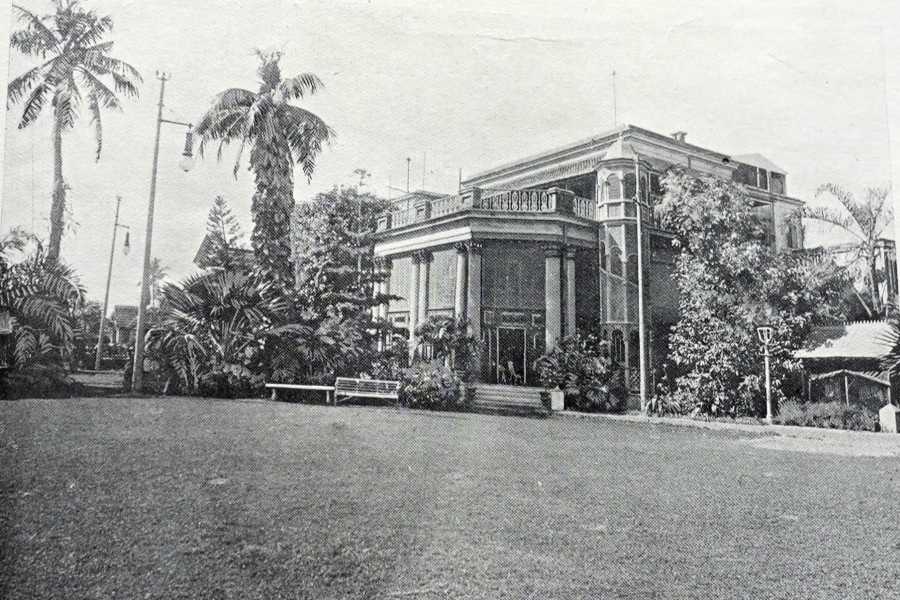
The Shyampukur Mitra Bati had a sprawling lawn, which no longer exists today From the collection of Sita Ghosh
The first mansion is a two-storied structure studded with Corinthian pillars and three small balconies described as “styled for Romeo and Juliet” by Soumitra Das in his book A Jaywalker's Guide to Calcutta. The design of the structure is similar to the top floor of Gazab restaurant, which makes you realise that it is a part of this mansion located outside on Shyampukur Street. Walking further, you reach the second mansion whose entrance is through a single-storied hall, also studded with Corinthian pillars. Sunil Gangopadhyay mentions visiting this mansion and teaching two kids. My first visit to Shyampukur Mitra Bati was also at this mansion.
Early history of Shyampukur Mitra Bati
The Mitra Bati at 34, Shyampukur Street, once belonged to barrister Rajnarayan Mitra. Little is known about him, except for an article written by Debasis Bose titled An Anglicized Patriot published in The Statesman on August 24, 1996. Rajnarayan was from the prominent Mitra family of Aatpur, Hooghly, which gained wealth during the time of Krishnaram Mitra, the Dewan of Maharaja Tilakchand of Burdwan. Krishnaram’s grandson, Radhanath Mitra, moved to Calcutta, married Heeramoni, daughter of Jagamohan Ghose of Shyampukur, and formed business ties with Dwarakanath Tagore. Radhanath later built a house at 32, Shyampukur Street. His son, Bireswar, died young, leaving behind Laxminarayan and Rajnarayan.
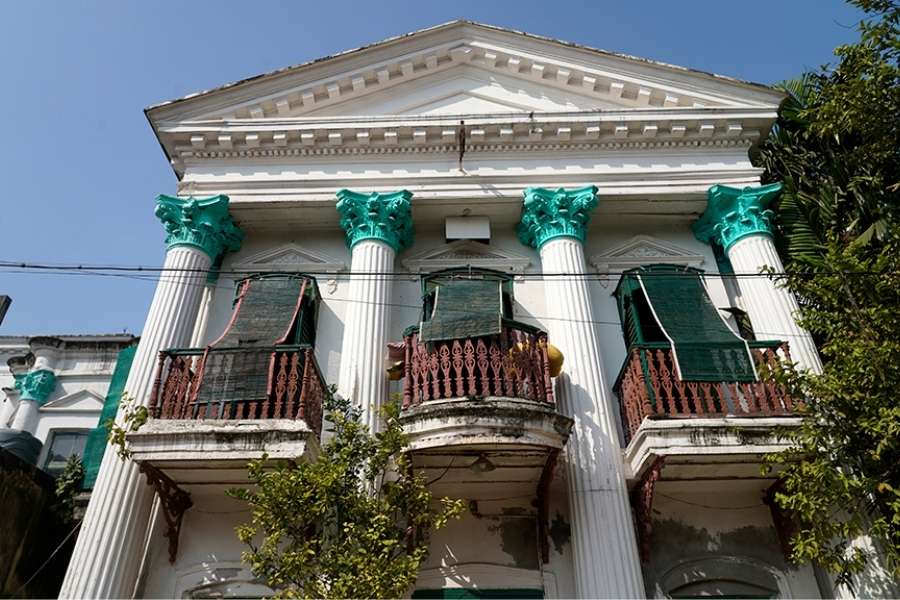
The two-storied mansion at the entry of Shyampukur Mitra Bati Amitabha Gupta
Rajnarayan went to Cambridge in the 1870s to earn his LLB and returned to Kolkata to practice law. His anglicised lifestyle, including consuming beef and alcohol, caused a rift with his more traditional wife, leading to their separation. Rajnarayan then built the palatial house at 34, Shyampukur Street. The mansion, as described by Debasis Bose, featured unique architecture, oil paintings, statues, period furniture, and a rare cut-glass fountain in the drawing room.
In 1904, diagnosed with laryngeal cancer, Rajnarayan planned to travel to Germany for treatment, but was concerned about his mansion and collection. He had befriended Girishchandra Mitra, son of Raja Digambar Mitra of Jhamapukur, during his time at Cambridge. Before his departure, Rajnarayan entrusted his house and collection to Girishchandra’s elder son, Manmathanath, in exchange for his passage fare. Rajnarayan died on August 7, 1905, in Berlin.
The era of Manmathanath Mitra
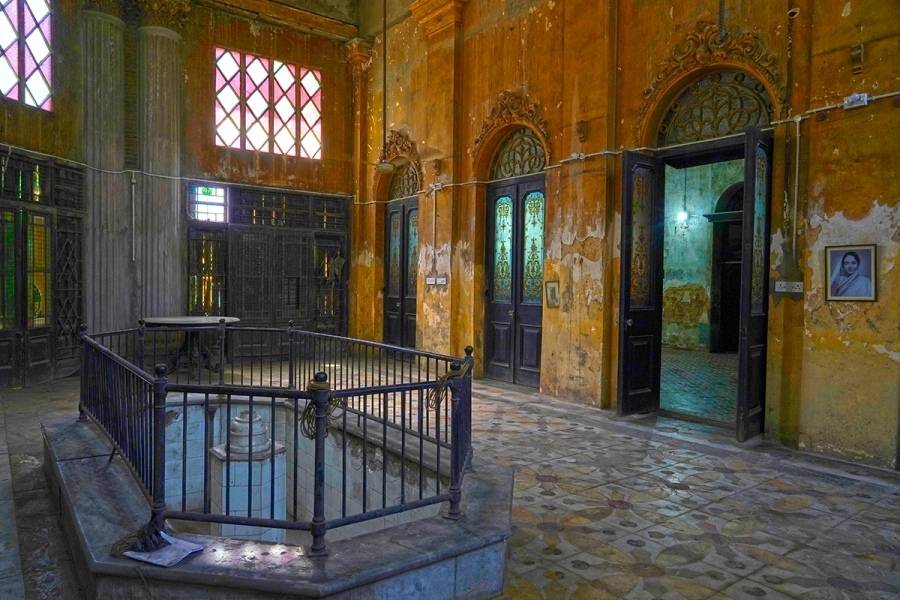
The present condition of the fountain room Amitabha Gupta
Born as the son of Shib Chandra Mitra of Konnagar in Hooghly district, Digambar Mitra was educated at Hare School and Hindu College and eventually became estate manager of Cossimbazar Raj, and ultimately, became a zamindar. He built a palatial residence at Jhamapukur, often referred to as Jhamapukur Rajbari.
Manmathanath Mitra moved out of Jhamapukur to his residence at 34, Shyampukur Street sometime in the early 1900s. Manmathanath added an inner residence, a kachari bari and a stable to that house. Debashish Bandopadhyay mentions in his book Banedi Kolkatar Gharbari that at one point of time, crocodiles were also kept in the small reservoir of the cut glass fountain. The fountain room was previously an open pavilion. Manmathanath transformed this pavilion into a room by enclosing pillars with wooden latticework and coloured glass. At one time, several antique paintings and other curios used to glorify this room and interior rooms of this house. That included large oil paintings by Gilhardy, Chinese vases, and statues. The house has a thakurdalan. But unlike the thakurdalan of other bonedi houses, no pompous puja is performed here. Whether it was done in the past or not, the descendants of today do not remember.
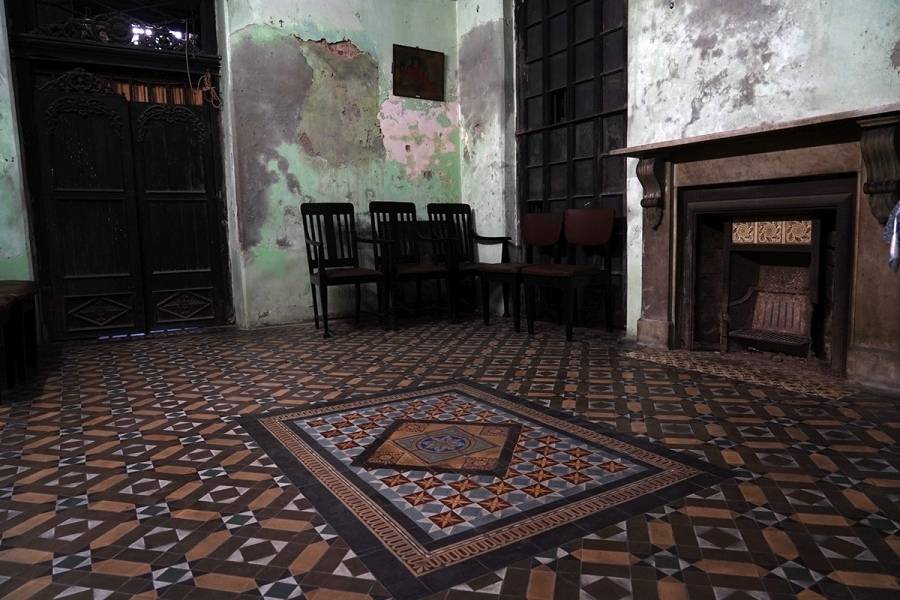
Almost all rooms of Shyampukur Mitra Bati had a fireplace Amitabha Gupta
Shyampukur Mitra Bati in present day
Manmathanath Mitra had seven sons and four daughters. The sons were named Sarat, Basanta, Hemanta, Shisir, Kiran, Bijoy and Sanat. Out of the four daughters, the youngest was Maya, who was married to Chief Justice of Kolkata, Himangshu Bose. The other daughters were Gouri, Renuka and Sudha.
Bijoy Kumar had three sons Amiya, Panchcowrie and Sashanka. After Bijoy Kumar’s wife’s untimely death, his three sons were adopted by other siblings. Sarat Chandra Mitra adopted Panchcowrie; Shisir Kumar Mitra adopted Amiya; and Kiran Kumar Mitra adopted Sashanka.
After Manmathanath, four of his sons and their descendants continued to stay at 34, Shyampukur Street. They were Sarat Chandra Mitra, Shisir Kumar Mitra, Hemanta Kiran Kumar Mitra and Kiran Kumar Mitra, and resided in different parts of this house. Bijoy Kumar mainly stayed at Ranchi, Sanat Kumar and Basanta Kumar stayed at their own separate houses.
Presently, at the first mansion of the house, stays the family of Chandan Mitra, the descendant of Panchcowrie Mitra. They occupy the major portion of the house. The thakurdalan is housed inside his portion, which, at present, is in a perilous state.
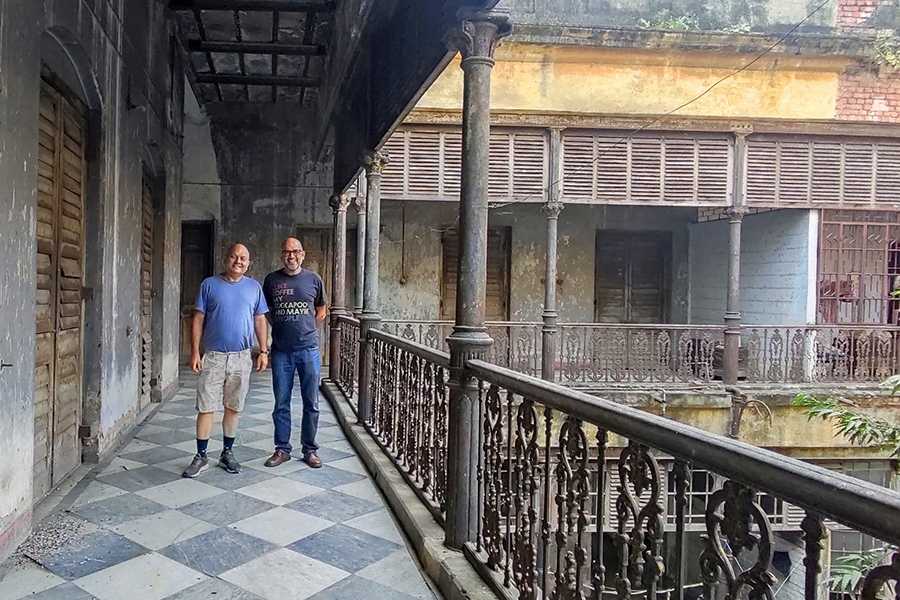
Rajib Bose and Rahul Bose on a verandah in the inner quarters of Shyampukur Mitra Bati Amitabha Gupta
The second mansion is the one that was made famous by Sunil Gangopdhyay in his writing. It is occupied by descendants of Kiran Kumar Mitra. Like all other portions, this also has a by number, which is 34G. Kiran Kumar had two sons – Mihir Kumar Mitra and Tapan Mitra. Tapan Mitra was a lawyer who later went into the transport business.
The curios and paintings of the house were mainly taken care of by Kiran Kumar Mitra, who was a connoisseur of art. The fountain room and its surrounding rooms were favourites for many eminent photographers like Raghubir Singh and Anne Benolken, among others. Filmmaker Satyajit Ray visited this house regularly, as he was a college mate of Mihir Kumar Mitra. Kiran Kumar was not in favour of having any film shot in the house. So, Ray adapted several designs from the fountain room and the adjacent living rooms and used them while designing the set of Charulata.
Tapan Mitra’s grandson, Arunava Mitra, showed me around the fountain room and others. The designs of the windows, doors, floors and ceilings are still in their original form. The fountain still exists — but has been nonfunctional for years.
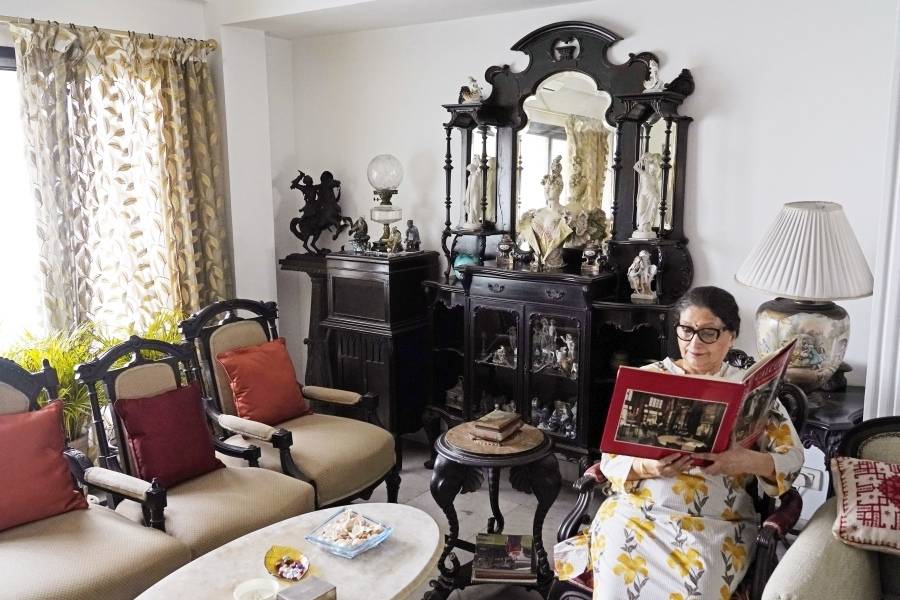
Sita Ghosh, in whose collection remains some of the family curios and old photographs, at her apartment near Kala Mandir Amitabha Gupta
Mihir Kumar Mitra was married to Smriti Ghosh hailing from the Khelat Ghosh family of Pathuriaghata. Their daughter Sita Ghosh, who is married with two daughters, presently resides at a flat close to Kala Mandir. She still preserves some of the statues of the fountain room in her apartment. In her late 70s, she fondly remembered the days when Sunil Gangopadhyay used to be her teacher. She is a repository of knowledge about the history of her famous family.
The inner quarters of the house, which was later built by Manmathanath Mitra, has a huge courtyard. One portion, numbered 34E, has been inherited by Gopa Basu, one of the five daughters of Shishir Kumar Mitra. His sons Rajib and Rahul Bose stay at Sunny Park and occasionally visit their ancestral house. One of Hemanta Kumar’s granddaughter, Ratna stays at the other portion of the house.
Sita Ghosh informed that she has been trying her best to preserve her portion of the ancestral property at Shyampukur Street along with Arunava Mitra. It is heartening to know that the fountain room of Shyampukur Mitra Bari is in safe hands.

